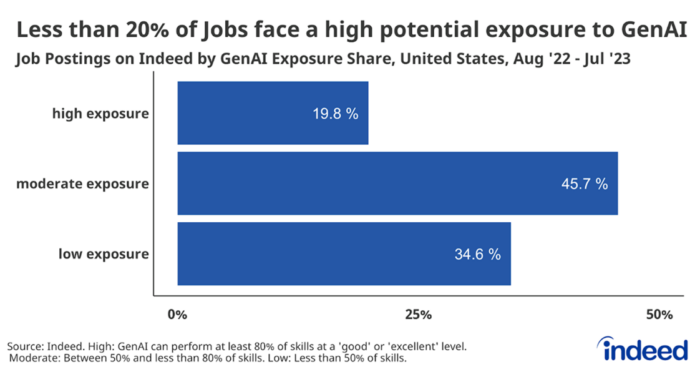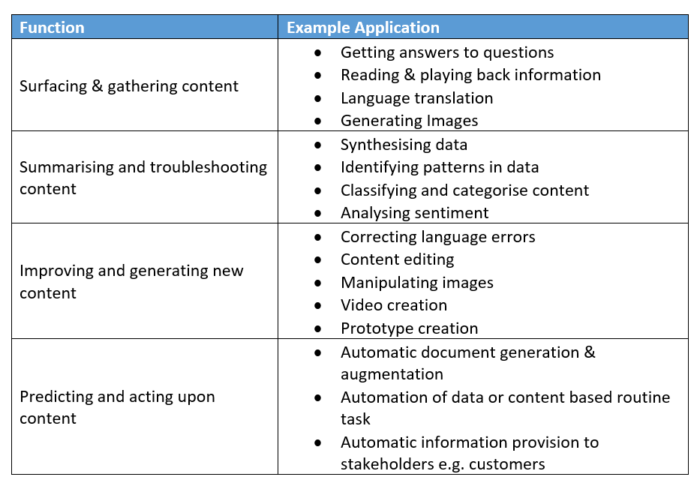
We are amid a GenAI revolution. GenAI burst into our personal and professional lives so abruptly in 2022 that many companies are still playing catch up. GenAI has been the fastest technology development in our lifetime. The rapidity of GenAI development continues daily with the emergence of new players, models, and functionality.
According to a GenAI benchmark study by Lucidworks from August last year, 96% of executives and managers involved in AI decision processes are actively prioritising GenAI investments, and 93% of organisations plan to increase their AI spend in the coming year. According to new 2024 figures, companies with 1,000 employees can save a whopping $16.5M per year in productivity with GenAI.
We all will have heard and seen the potential negative impacts of AI, for example, that it could lead to role replacement and redundancy. GenAI will mean disruption for people, that much is clear. GenAI will make the daily activities of our workforces less frustrating and tedious becoming more positive and fulfilling. I do believe that organisations that implement GenAI well and actively focus on reskilling and upskilling employees, will be the most competitive in the long run. This will be because the capabilities needed to succeed in an AI era will already exist within the organisation.
According to new 2024 figures, GenAI saves professionals one day a week in productivity. It is already therefore having a significant impact where it is being deployed. BCG Surveyed 12,800 frontline employees, managers, and leaders in 18 countries around the world to understand how the evolution of AI has impacted the workplace. They found that “Optimism is Rising and Concern is Falling” over the impact of GenAI with 71% of respondents believing that the potential rewards of GenAI outweigh the possible risks.
GenAI democratises AI for employees
Organisations need to act now if they are to leverage the opportunities that GenAI presents to gain a competitive advantage. GenAI has opened the door to AI for us all. No longer is Artificial Intelligence about complex maths, coding, and algorithms; GenAI works in our natural languages and is instantly accessible to everyone.
Even if you haven’t articulated your enterprise GenAI strategy yet, like it or not, GenAI is likely to be active in your organisation. Your employees could well be using the likes of ChatGPT or Claude to search for information more quickly than without GenAI, to carry out tasks. According to a US survey three months after ChatGPT’s public launch AI tools were being used by 68% of employees without their bosses’ knowledge.
GenAI is seeping into our organisations. Google, Microsoft Office, Oracle, Workday, ServiceNow, Salesforce, and other software providers have and will continue to embed generative AI capabilities in their offerings.
Employees themselves are positive about the effect of GenAI
According to PwC’s Global Workforce Hopes and Fears Survey 2023, 52% of the 54,000 employees surveyed in 46 countries and territories, expect AI to impact their career positively over the next five years, 31% believe that it will increase their productivity/efficiency at work, and 27% view AI as an opportunity to learn new skills.
In a 2024 ‘State of Business’ study of those employees who have used GenAI at work over the last year, 80% of workers say GenAI improves the quality of their work.
GenAI will have a greater impact on white-collar roles over the next 10 years
Most jobs face some potential impact by GenAI, but this will vary by the type of role, the sector, and the geography. Indeed conducted a survey where they looked at the impact of GenAI on a wide range of roles. According to their findings, only 19.8% of jobs face a high level of potential exposure or risk due to GenAI.

GenAI will redefine roles in one way or another. It should complement and augment rather than completely replace jobs, automating routine tasks to free up time for more fulfilling work. Clerical work is expected to experience the most significant impact which is believed to have a potential disproportionate impact on females due to over-representation of women in these clerical roles. Over-representation of women in such roles is particularly the case in affluent nations. Organisations need to consider this factor to ensure a continued focus on diversity.
It is estimated that white-collar roles will be more impacted than blue collar, this is because many white-collar roles contain repetitive and technical tasks that can easily be replicated by GenAI. A Pearson study below shows how that may play out across a few different geographies.

Engineering, life sciences, computer, mathematical, and legal sectors are the most highly exposed to GenAI, while the social, education, food services, and personal care services sectors are least exposed.
Empower your people to be more effective with GenAI
A GenAI augmented workforce, will be an enhanced workforce. The opportunity of GenAI is not only the promise of greater efficiency for organisations but also a possibility for people to redirect their time, energy, and efforts away from tasks that GenAI can take over.
GenAI provides people with 4 main levels of functionality that can help them do their jobs better and more quickly.

Given the average employee spends 3.6 hours daily searching for information and 19 hours or half of the workweek on writing tasks, GenAI provides powerful functionality to augment most roles.
Reimagining how people get things done
I’ve been helping clients with their approach and strategy for GenAI for most of this year including defining impactful use cases, technology strategy, benefits realisation, and guardrails through to delivery approaches. However, a key part that is often neglected is preparation of the impact of GenAI on people and their work.
GenAI can transform entire business processes, functions, and day-to-day business operations to increase productivity, drive better business outcomes, and bring about new and better ways of working; but what does it mean for the individual and how can it be integrated into daily work?
Some of the ways that GenAI can enhance individuals’ roles are:
- Increasing productivity and sense of achievement
- Reducing manual activities
- Removing repetitive and tedious tasks
- Allowing more time for more fulfilling and challenging activities
- Creating opportunities to learn new skills
Organisations need to begin by assessing and mapping out roles, activities, and workflows across the different functions or areas of the business to see how they can be redefined by GenAI.
Roles can be decomposed into their component tasks and then grouped by the opportunity to augment or automate i.e.,
- those that can continue to be performed by humans
- those that can be fully automated (gathering, classifying)
- those that can be enhanced to help humans work more effectively
People Strategy Considerations
Beyond job and task redesign, it is clear organisations will need to support their employees in preparation for changes in their work and to help them succeed in adopting GenAI in the future human and machine workplace. It is reported that 52% of workers don’t know how to use AI effectively.
According to the aforementioned BCG study, 86% of respondents say they will need GenAI training but that just 14% of frontline employees have received any.
10 GenAI People strategy considerations:
- Role/capability mapping & hiring strategy: what does the organisation have, what does/ will it need and what are the gaps e.g. new roles such as a prompt engineer
- Skills assessment: conducting skills assessments to identify areas where employees can benefit from additional training or development
- Education & training: comprehensive employee training programmes on GenAI tools to help people embrace the new technology and understand how it may affect their roles
- Upskilling: there will be key skills needed that complement the use of GenAI including data analysis, prompt formulation, critical thinking, and problem-solving. Regular upskilling is needed given the pace at which GenAI is evolving. Upskilling will not be a one-off initiative.
- Career development: help people explore new career paths and opportunities that arise due to GenAI such as AI ethics or GenAI development roles
- Job transition planning and career path guidance: providing counseling and guidance to help employees identify suitable paths within the organisation as their roles evolve and a smoother and more transition to new roles and responsibilities
- Internal mobility programmes: promoting internal job mobility, allowing employees to explore new positions within the company, especially those related to GenAI
- Collaboration with GenAI: encourage collaboration between employees and GenAI platforms to enhance productivity and creativity. Encourage a mindset of human-AI teamwork
- Continuous learning culture: fostering a culture of continuous learning and adaptability
- Feedback mechanisms: establish channels for employees to provide feedback on the GenAI tools that they use, to encourage continuous improvement
What is becoming clear is that GenAI will impact tasks, rather than occupations per se. Some of these tasks can and will be automated, others will be transformed with the assistance of GenAI, and some could be unchanged. Successful GenAI in any human enterprise will enhance and empower employees with new ‘superpowers’ to do their jobs better rather than trying to replace them. Those companies that aim to take full advantage of GenAI and leverage it as a differentiator, will be those who envisage and proactively provide their people with guidance, education, and training, to ensure that they use these new capabilities securely, effectively, and then adapt to the changes that GenAI will bring over the coming weeks, months and years.
2023 was a year of experimentation, 2024 is likely to continue to be so. We’re now seeing some credible statistics about the impact that GenAI is already having in the workplace. An IBM study has found that 43% of responding CEOs said they’ve already reduced or redeployed their workforces due to GenAI, with another 28% stating that they plan to do so in the coming year. In their 2024 workplace predictions, Gartner said “AI will likely create and not diminish workforce opportunities”.
We are all learning about these new technologies as the world of GenAI is changing every single day. We all need to upskill. GenAI is a story of augmentation. So far, in my experience that does seem to be the case. Organisations need to get on board, continue to experiment, test and learn safely and responsibly; proactively ensuring that GenAI is a catalyst for workforce enhancement. We can all fully prepare for the challenges and opportunities of an AI-driven future, one where Happy Employees means Smiling Companies.



